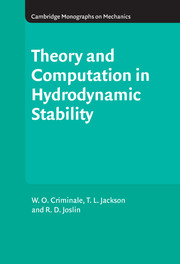Book contents
- Frontmatter
- Contents
- Figures
- Tables
- Preface
- 1 Introduction and problem formulation
- 2 Temporal stability of inviscid incompressible flows
- 3 Temporal stability of viscous incompressible flows
- 4 Spatial stability of incompressible flows
- 5 Stability of compressible flows
- 6 Centrifugal stability
- 7 Geophysical flow
- 8 Transient dynamics
- 9 Nonlinear stability
- 10 Transition and receptivity
- 11 Direct numerical simulation
- 12 Flow control and optimization
- 13 Investigating hydrodynamic instabilities with experiments
- References
- Author index
- General index
3 - Temporal stability of viscous incompressible flows
Published online by Cambridge University Press: 06 July 2010
- Frontmatter
- Contents
- Figures
- Tables
- Preface
- 1 Introduction and problem formulation
- 2 Temporal stability of inviscid incompressible flows
- 3 Temporal stability of viscous incompressible flows
- 4 Spatial stability of incompressible flows
- 5 Stability of compressible flows
- 6 Centrifugal stability
- 7 Geophysical flow
- 8 Transient dynamics
- 9 Nonlinear stability
- 10 Transition and receptivity
- 11 Direct numerical simulation
- 12 Flow control and optimization
- 13 Investigating hydrodynamic instabilities with experiments
- References
- Author index
- General index
Summary
Discussion
When a parallel or nearly parallel mean flow does not have an inflection point, viscous effects are important and the Orr-Sommerfeld equation (2.31) must be considered in order to determine the stability of the flow. This is in contrast to solving the much simpler Rayleigh's equation (2.32) where it is generally believed that, for flows with an inflection point, the most unstable mode is inviscid in nature.
In this chapter we will examine the temporal stability characteristics of various well known profiles. These profiles include bounded flows, such as plane Poiseuille and Couette flows, semi-bounded flows, such as the Blasius boundary layer and the more general Falkner-Skan family, and unbounded flows, such as jets, wakes and mixing layers. Other well-known profiles are given in the exercise section. We restrict our attention to two-dimensional disturbances, since according to Squire's theorem, if a three-dimensional disturbance is unstable, there corresponds a more unstable two-dimensional disturbance.
For bounded flows, DiPrima & Habetler (1969) proved that the spectrum of the Orr-Sommerfeld equation consists of an infinite number of discrete eigenvalues, and that the spectrum is complete. Contrary to this, if perturbations for this flow are considered inviscidly, then there are no discrete modes. As a result, only a continuous spectrum is possible. Thus, any arbitrary initial disturbance can be decomposed and expressed as a linear combination of the eigenfunctions. For unbounded flows, stability calculations for various flows have uncovered only a finite number of eigenvalues.
- Type
- Chapter
- Information
- Theory and Computation of Hydrodynamic Stability , pp. 76 - 101Publisher: Cambridge University PressPrint publication year: 2003



